
USS Galena was a wooden-hulled broadside ironclad built for the United States Navy during the American Civil War. The ship was initially assigned to the North Atlantic Blockading Squadron and supported Union forces during the Peninsula Campaign in 1862. She was damaged during the Battle of Drewry's Bluff because her armor was too thin to prevent Confederate shots from penetrating. Widely regarded as a failure, Galena was reconstructed without most of her armor in 1863 and transferred to the West Gulf Blockading Squadron in 1864. The ship participated in the Battle of Mobile Bay and the subsequent Siege of Fort Morgan in August. She was briefly transferred to the East Gulf Blockading Squadron in September before she was sent to Philadelphia, Pennsylvania for repairs in November.
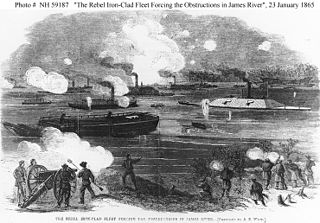
CSS Virginia II was a Confederate Navy steam-powered ironclad ram laid down in 1862 at the William Graves' shipyard in Richmond, Virginia. Acting Constructor William A. Graves, CSN, was the superintendent in charge of her construction. In order to conserve scarce iron plating, he ordered the ship's armored casemate shortened from the specifications given in John L. Porter's original building plans; in addition, the ship's iron-plating, while six inches thick on the casemate's forward face, was reduced to five inches on her port, starboard, and aft faces. Due to the shortening of her casemate, the number of her cannon were reduced to a single 11" smoothbore, a single 8" rifle, and two 6.4" rifles.

CSS Richmond was the name ship of her class of six casemate ironclads built for the Confederate States Navy during the American Civil War. Completed during 1862 the ship was assigned to the James River Squadron where she mostly supported Confederate forces near Richmond, Virginia. She was burned in April 1865 to prevent her capture by Union forces.

USS Canonicus was a single-turret monitor built for the United States Navy during the American Civil War, the lead ship of her class. The ship spent most of her first year in service stationed up the James River, where she could support operations against Richmond and defend against a sortie by the Confederate ironclads of the James River Squadron. She engaged Confederate artillery batteries during the year and later participated in both attacks on Fort Fisher, defending the approaches to Wilmington, North Carolina, from December 1864 to January 1865.

CSS Fredericksburg was a casemate ironclad that served as part of the James River Squadron of the Confederate States Navy during the American Civil War. Laid down in 1862 and Launched the following year, she did not see action until 1864 due to delays in receiving her armor and guns. After passing through the obstructions at Drewry's Bluff in May 1864, she participated in several minor actions on the James River and fought in the Battle of Chaffin's Farm from September 29 to October 1. On January 23 and 24, 1865, she was part of the Confederate fleet at the Battle of Trent's Reach, and was one of only two Confederate ships to make it past the obstructions at Trent's Reach. After the Confederate attack failed, Fredericksburg withdrew with the rest of the James River Squadron. On April 3, as the Confederates were abandoning Richmond, Fredericksburg and the other vessels of the James River Squadron were burned. Her wreck was located in the 1980s, buried under sediment.
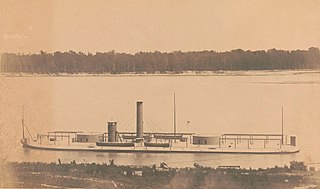
USS Chickasaw was an ironclad Milwaukee-class river monitor built for the United States Navy during the American Civil War. The ship participated in the Battle of Mobile Bay in August 1864, during which she was lightly damaged, and the bombardments of Forts Gaines and Morgan as Union troops besieged the fortifications defending the bay. In March–April 1865, Chickasaw again supported Union forces during the Mobile Campaign as they attacked Confederate fortifications defending the city of Mobile, Alabama.
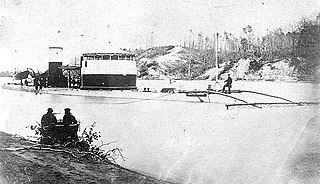
USS Saugus was a single-turreted Canonicus-class monitor built for the Union Navy during the American Civil War. The vessel was assigned to the James River Flotilla of the North Atlantic Blockading Squadron upon completion in April 1864. The ship spent most of her time stationed up the James River where she could support operations against Richmond and defend against a sortie by the Confederate ironclads of the James River Squadron. She engaged Confederate artillery batteries during the year and later participated in both attacks on Fort Fisher, defending the approaches to Wilmington, North Carolina, in December 1864 – January 1865. Saugus returned to the James River after the capture of Fort Fisher and remained there until Richmond, Virginia, was occupied in early April.
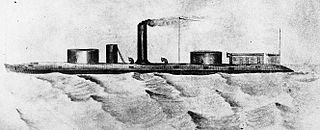
USS Winnebago was a double-turret Milwaukee-class river monitor, named for the Winnebago tribe of Siouan Indians, built for the Union Navy during the American Civil War. The ship participated in the Battle of Mobile Bay in 1864, during which she was lightly damaged, and the bombardments of Forts Gaines and Morgan as Union troops besieged the fortifications defending the bay. In early 1865, Winnebago again supported Union forces during the Mobile Campaign as they attacked Confederate fortifications defending the city of Mobile, Alabama. She was placed in reserve after the end of the war and sold in 1874.
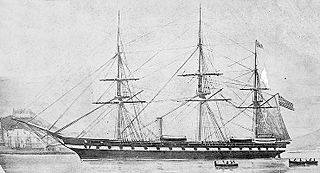
USS Roanoke was a wooden-hulled Merrimack-class screw frigate built for the United States Navy in the mid-1850s. She served as flagship of the Home Squadron in the late 1850s and captured several Confederate ships after the start of the American Civil War in 1861. The ship was converted into an ironclad monitor during 1862–63; the first ship with more than two gun turrets in history. Her conversion was not very successful as she rolled excessively and the weight of her armor and turrets strained her hull. Her deep draft meant that she could not operate off shallow Confederate ports and she was relegated to harbor defense at Hampton Roads, Virginia for the duration of the war. Roanoke was placed in reserve after the war and sold for scrap in 1883.

USS Neosho, the lead ship of her class, was an ironclad river monitor laid down for the Union Navy in the summer of 1862 during the American Civil War. After completion in mid-1863, the ship spent time patrolling the Mississippi River against Confederate raids and ambushes as part of Rear Admiral David Porter's Mississippi Squadron. She participated in the Red River Campaign in March–May 1864. Neosho resumed her patrols on the Mississippi after the end of the campaign. She supported the Union Army's operations on the Cumberland River and provided fire support during the Battle of Nashville in December 1864. Neosho was decommissioned after the war and remained in reserve until sold in 1873.
The first USS Milwaukee, a double-turreted Milwaukee-class river monitor, the lead ship of her class, built for the Union Navy during the American Civil War. The ship supported Union forces during the Mobile Campaign as they attacked Confederate fortifications defending the city of Mobile, Alabama in early 1865. She struck a mine in March and sank without loss. Her wreck was raised in 1868 and broken up for scrap that was used in the construction of a bridge in St. Louis, Missouri.
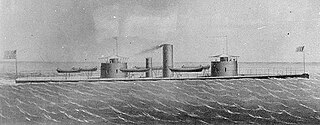
USS Monadnock was one of four Miantonomoh-class monitors built for the United States Navy during the American Civil War. Commissioned in late 1864, she participated in the First in December and Second Battles of Fort Fisher in January 1865. The ship was later assigned to the James River Flotilla on the approaches to the Confederate capitol of Richmond, Virginia and then sailed to Spanish Cuba to intercept the Confederate ironclad CSS Stonewall.

USS Manhattan was a single-turreted Canonicus-class monitor built for the Union Navy during the American Civil War. After commissioning in 1864 the ship was assigned to the West Gulf Blockading Squadron and participated in the Battle of Mobile Bay. At the end of the battle, Manhattan took the surrender of the Confederate casemate ironclad ram Tennessee. She bombarded Fort Morgan during the Siege of Fort Morgan and later blockaded the mouth of the Red River until the end of the war.

USS Mahopac (1864) was a Canonicus-class monitor built for the Union Navy during the American Civil War. The vessel was assigned to the James River Flotilla of the North Atlantic Blockading Squadron upon completion in September 1864. The ship spent most of her time stationed up the James River where she could support operations against Richmond and defend against sorties by the Confederate ironclads of the James River Squadron. She engaged Confederate artillery batteries during the year and later participated in both the first and second battles of Fort Fisher, defending the approaches to Wilmington, North Carolina, in December 1864 – January 1865. Mahopac returned to the James River after the capture of Fort Fisher and remained there until Richmond, Virginia was occupied in early April.

The French ironclad Colbert was the lead ship of the Colbert-class ironclads that were built for the French Navy in the 1870s. The ship was the flagship of the Mediterranean Squadron for most of her career. She took part in the French conquest of Tunisia, notably shelling and landing troops in Sfax on 15–16 July 1881. Colbert was paid off in 1895 and condemned in 1900. The ship was finally sold for scrap in 1909.

The French ironclad Armide was a wooden-hulled armored corvette built for the French Navy in the mid-1860s. Placed into reserve after completion, she was first mobilized for the Franco-Prussian War of 1870–1871. She spent the rest of her career in the Mediterranean and then in the Far East as flagship of the French squadrons there, until her decommissioning in 1880. Armide was use as a target for gunnery trials in 1886.

The Neosho-class monitors were a pair of ironclad river monitors laid down in mid-1862 for the United States Navy during the American Civil War. After completion in mid-1863, both ships spent time patrolling the Mississippi River against Confederate raids and ambushes as part of Rear Admiral David Porter's Mississippi Squadron. Both ships participated in the Red River Campaign in March–May 1864, although Osage supported the capture of Fort DeRussy in March and participated in the Battle of Blair's Landing in April. Osage was grounded on a sandbar for six months after the end of the campaign while Neosho resumed her patrols on the Mississippi. The latter ship supported the Union Army's operations on the Cumberland River and provided fire support during the Battle of Nashville in December.
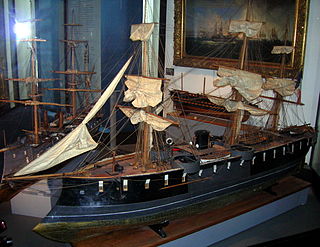
The Océan-class ironclads were a class of three wooden-hulled armored frigates built for the French Navy in the mid to late 1860s. Océan attempted to blockade Prussian ports in the Baltic Sea in 1870 during the Franco-Prussian War and Marengo participated in the French conquest of Tunisia in 1881. Suffren was often used as the flagship for the Cherbourg Division, the Channel Division, Mediterranean Squadron and the Northern Squadron during her career. The ships were discarded during the 1890s.

Triomphante (Triumphant) was the third and last ship of the La Galissonnière class of wooden-hulled, armored corvettes built for the French Navy during the 1870s. Her construction was delayed for years and the navy took advantage of the extended construction time to upgrade her armament in comparison to the lead ship, La Galissonnière. She and her half-sister La Galissonnière participated in a number of battles during the Sino-French War of 1884–85. The ship remained in Asia and never returned to France after the war. She was condemned in 1896 and sold in 1903.
The Milwaukee-class monitors were a class of four riverine ironclad monitors built during the American Civil War. Several supported Union forces along the Mississippi River in mid-1864 before participating in the Battle of Mobile Bay in August. Chickasaw and Winnebago bombarded Confederate coastal fortifications during the battle and during subsequent operations as well as engaging the ironclad Tennessee II. The other two ships arrived at Mobile Bay after the battle and all four supported the land attacks on Mobile in March–April 1865. Milwaukee struck a torpedo during this time and sank. The surviving three ships were sold in 1874; Chickasaw was converted into a ferry and survived until 1944 when she was scuttled. Her wreck was discovered in 2004.




















